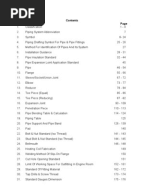Copper Tube Handbook Introduction / Table of Contents CDA has converted the Copper Tube Handbook into an app for either your tablet or smartphone. The new app makes it easier and quicker for plumbers, HVAC technicians and contractors to obtain information about copper tube, piping and fitting as well as different joining methods and applications. Available from the or, users now have this 80+ page manual available on their mobile devices whenever and wherever they need it.
Since primitive man first discovered copper, the red metal has constantly served the advancement of civilization. Archeologists probing ancient ruins have discovered that this enduring metal was a great boon to many peoples. Tools for handicraft and agriculture, weapons for hunting, and articles for decorative and household uses were wrought from copper by early civilizations. The craftsmen who built the great pyramid for the Egyptian Pharaoh Cheops fashioned copper pipe to convey water to the royal bath. Cengel Termodinamica E Trasmissione Del Calore Pdf Italic Font there. A remnant of this pipe was unearthed some years ago still in usable condition, a testimonial to copper's durability and resistance to corrosion. Modern technology, recognizing that no material is superior to copper for conveying water, has reconfirmed it as the prime material for such purposes.

Years of trouble-free service in installations here and abroad have built a new reputation for copper piping in its modern form—light, strong, corrosion resistant tube. It serves all kinds of buildings: single-family homes, high-rise apartments and industrial, commercial and office buildings. Today, copper tube for the plumbing, heating and air-conditioning industries is available in drawn and annealed tempers (referred to in the trades as 'hard' and 'soft') and in a wide range of diameters and wall thicknesses. Readily available fittings serve every design application. Joints are simple, reliable and economical to make—additional reasons for selecting copper tube. Today, nearly 5,000 years after Cheops, copper developments continue as the industry pioneers broader uses for copper tube in engineered plumbing systems for new and retrofitted residential, industrial and commercial installations. Access the complete Copper Tube Handbook: • This section of the Copper Tube Handbook describes the different types of copper tube, their properties and how to identify them.
• • • • This section highlights the advantages of copper tube and offers recommendations for various applications. • • • This section provides design and installation data for a variety of copper tube applications and uses in systems such as pressure systems, drainage, solar energy, agriculture, etc. • • • • • • • • • • • • Because of its exceptional formability, copper can be formed as desired at the job site. Copper tube, properly bent, will not collapse on the outside of the bend and will not buckle on the inside of the bend. Tests demonstrate that the bursting strength of a bent copper tube can actually be greater than it was before bending. • There are three categories of methods to join copper tubing: Solder or Brazed Joints, No-flame Joints, and Additional Joining Methods. • Soldered joints, with capillary fittings, are used in plumbing for water lines and for sanitary drainage.
Brazed joints, with capillary fittings, are used where greater joint strength is required or where service temperatures are as high as 350°F. Brazing is preferred, and often required, for joints in refrigeration piping. • • • • The American Welding Society defines soldering as 'a group of joining processes that produce coalescence of materials by heating them to a soldering temperature and by using a filler metal (solder) having a liquidus not exceeding 840°F and below the solidus of the base metals.' In actual practice, most soldering is done at temperatures from about 350°F to 600°F.
• • • • • • • • • • Strong, leak-tight brazed connections for copper tube may be made by brazing with filler metals which melt at temperatures in the range between 1100° F and 1500° F. Brazing filler metals are sometimes referred to as 'hard solders' or 'silver solders.' These confusing terms should be avoided. • • • • • • • • • • While copper tube is usually joined by soldering or brazing, there are times when a mechanical joint may be required or preferred. Flared fittings are an alternative when the use of an open flame is either not desired or impractical. • Grooved-end piping has been familiar to pipe fitters and sprinkler system contractors for many years. Since 1925, this method of joining pipe has been used reliably on steel and iron pipe in HVAC, fire protection, process piping and related applications.
• • • • Press-connect joining of copper and copper alloy tube is fast, economical, and, most importantly, it requires no heat or open flame unlike soldering or brazing. • • • • • Like the press-connect joining method, the push-connect joining of copper and copper alloy tube is fast, economical and, also, requires no heat or open flame. • • • • Another joining technology that has been used effectively for many years involves a hand tool designed to quickly pull tee connections and outlets from the run of the tube, thus reducing the number of tee fittings and soldered or brazed joints. • • • • Index of Tables and Figures that represent the supporting technical data.
Pipe Fitter Handbook - Download as PDF File (.pdf), Text File (.txt) or read online. Steam And Gas Turbine By R Yadav Ebook Download.
